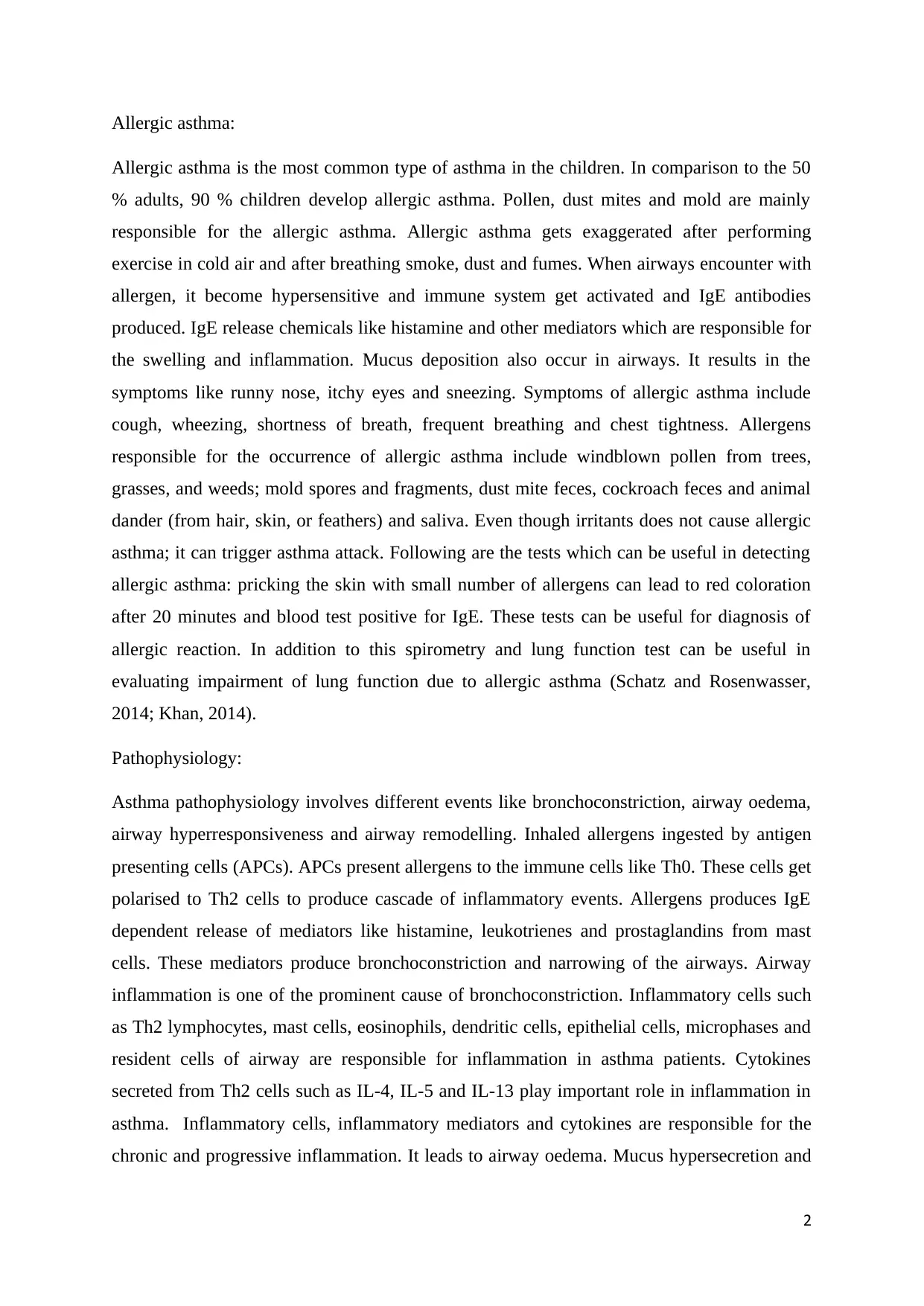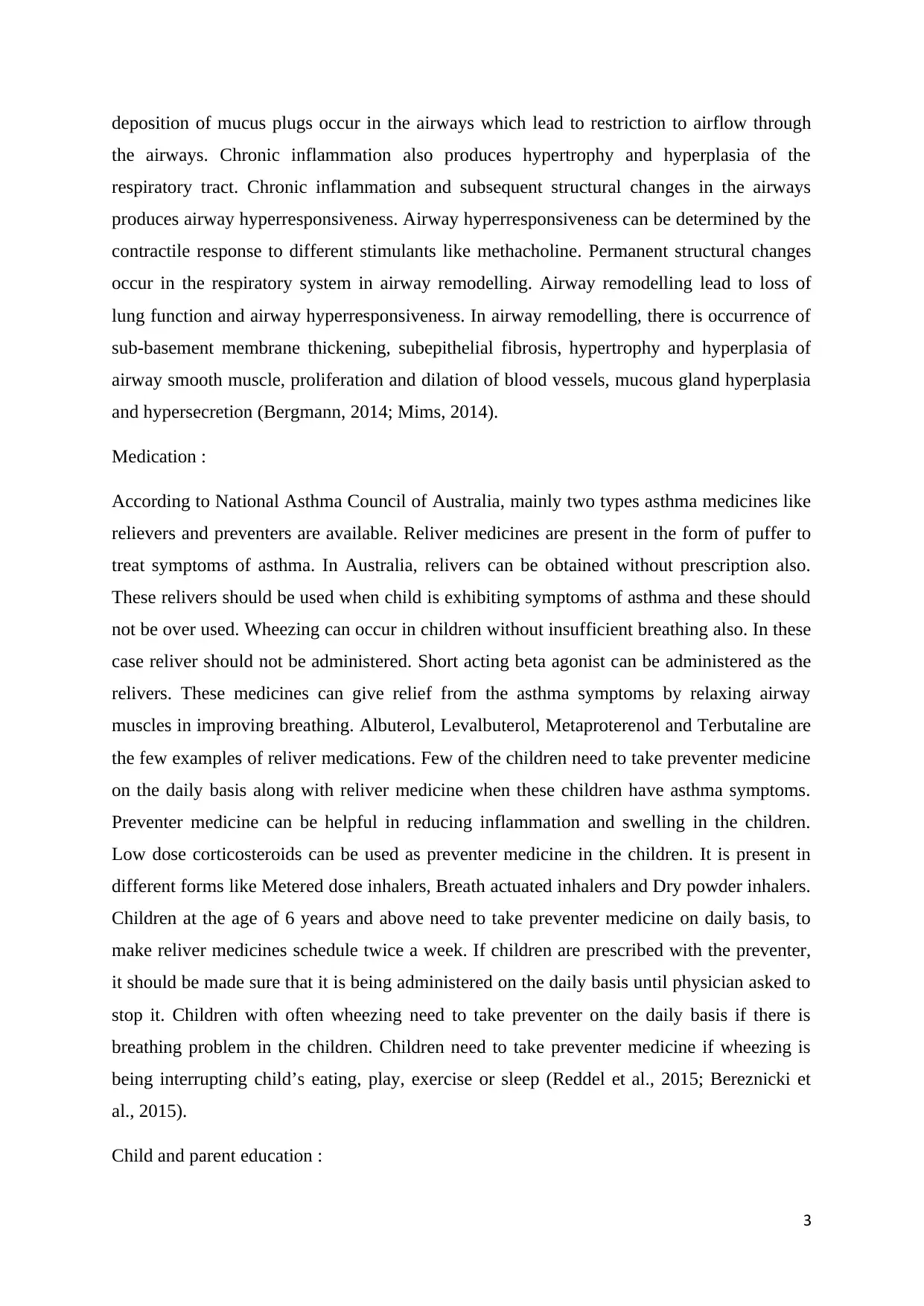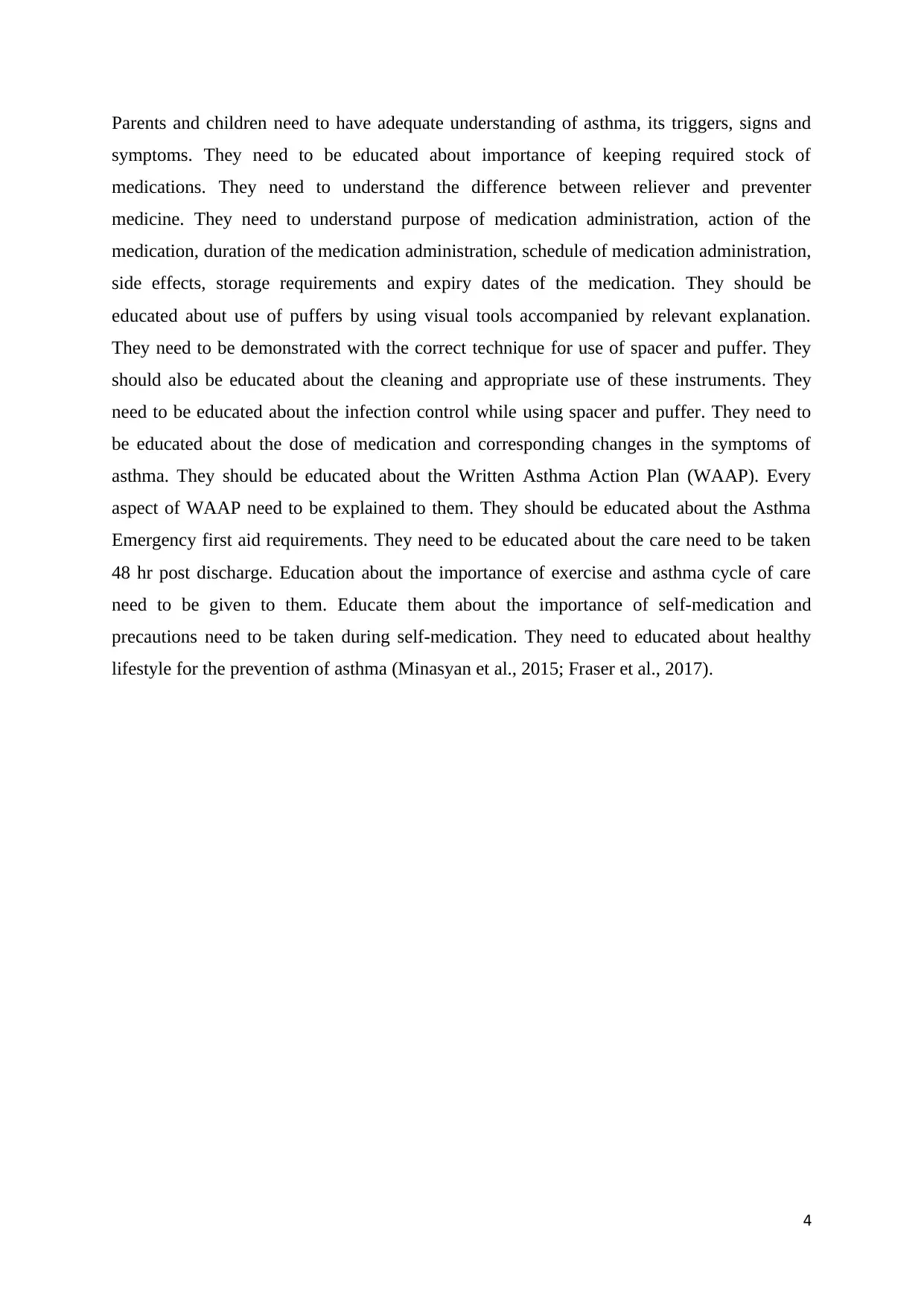Allergic Asthma: Pathophysiology, Medications, and Education
VerifiedAdded on 2021/05/31
|5
|1450
|42
Report
AI Summary
This report provides a detailed analysis of allergic asthma, a common condition particularly affecting children. It begins by defining allergic asthma, differentiating it from other types, and highlighting common triggers such as pollen, dust mites, and mold. The report explores the pathophysiology, including the role of IgE antibodies, histamine, and other mediators in causing airway inflammation, bronchoconstriction, and mucus deposition. It also covers diagnostic tests like skin pricks and blood tests. The report then delves into the medications used, distinguishing between relievers (e.g., short-acting beta agonists) and preventers (e.g., low-dose corticosteroids), along with their administration methods and usage guidelines. Furthermore, the report emphasizes the importance of educating both children and parents about asthma, including understanding triggers, recognizing symptoms, managing medications, and utilizing Written Asthma Action Plans. The report concludes with a comprehensive list of references for further study.

Body Integrity
1
1
Paraphrase This Document
Need a fresh take? Get an instant paraphrase of this document with our AI Paraphraser

Allergic asthma:
Allergic asthma is the most common type of asthma in the children. In comparison to the 50
% adults, 90 % children develop allergic asthma. Pollen, dust mites and mold are mainly
responsible for the allergic asthma. Allergic asthma gets exaggerated after performing
exercise in cold air and after breathing smoke, dust and fumes. When airways encounter with
allergen, it become hypersensitive and immune system get activated and IgE antibodies
produced. IgE release chemicals like histamine and other mediators which are responsible for
the swelling and inflammation. Mucus deposition also occur in airways. It results in the
symptoms like runny nose, itchy eyes and sneezing. Symptoms of allergic asthma include
cough, wheezing, shortness of breath, frequent breathing and chest tightness. Allergens
responsible for the occurrence of allergic asthma include windblown pollen from trees,
grasses, and weeds; mold spores and fragments, dust mite feces, cockroach feces and animal
dander (from hair, skin, or feathers) and saliva. Even though irritants does not cause allergic
asthma; it can trigger asthma attack. Following are the tests which can be useful in detecting
allergic asthma: pricking the skin with small number of allergens can lead to red coloration
after 20 minutes and blood test positive for IgE. These tests can be useful for diagnosis of
allergic reaction. In addition to this spirometry and lung function test can be useful in
evaluating impairment of lung function due to allergic asthma (Schatz and Rosenwasser,
2014; Khan, 2014).
Pathophysiology:
Asthma pathophysiology involves different events like bronchoconstriction, airway oedema,
airway hyperresponsiveness and airway remodelling. Inhaled allergens ingested by antigen
presenting cells (APCs). APCs present allergens to the immune cells like Th0. These cells get
polarised to Th2 cells to produce cascade of inflammatory events. Allergens produces IgE
dependent release of mediators like histamine, leukotrienes and prostaglandins from mast
cells. These mediators produce bronchoconstriction and narrowing of the airways. Airway
inflammation is one of the prominent cause of bronchoconstriction. Inflammatory cells such
as Th2 lymphocytes, mast cells, eosinophils, dendritic cells, epithelial cells, microphases and
resident cells of airway are responsible for inflammation in asthma patients. Cytokines
secreted from Th2 cells such as IL-4, IL-5 and IL-13 play important role in inflammation in
asthma. Inflammatory cells, inflammatory mediators and cytokines are responsible for the
chronic and progressive inflammation. It leads to airway oedema. Mucus hypersecretion and
2
Allergic asthma is the most common type of asthma in the children. In comparison to the 50
% adults, 90 % children develop allergic asthma. Pollen, dust mites and mold are mainly
responsible for the allergic asthma. Allergic asthma gets exaggerated after performing
exercise in cold air and after breathing smoke, dust and fumes. When airways encounter with
allergen, it become hypersensitive and immune system get activated and IgE antibodies
produced. IgE release chemicals like histamine and other mediators which are responsible for
the swelling and inflammation. Mucus deposition also occur in airways. It results in the
symptoms like runny nose, itchy eyes and sneezing. Symptoms of allergic asthma include
cough, wheezing, shortness of breath, frequent breathing and chest tightness. Allergens
responsible for the occurrence of allergic asthma include windblown pollen from trees,
grasses, and weeds; mold spores and fragments, dust mite feces, cockroach feces and animal
dander (from hair, skin, or feathers) and saliva. Even though irritants does not cause allergic
asthma; it can trigger asthma attack. Following are the tests which can be useful in detecting
allergic asthma: pricking the skin with small number of allergens can lead to red coloration
after 20 minutes and blood test positive for IgE. These tests can be useful for diagnosis of
allergic reaction. In addition to this spirometry and lung function test can be useful in
evaluating impairment of lung function due to allergic asthma (Schatz and Rosenwasser,
2014; Khan, 2014).
Pathophysiology:
Asthma pathophysiology involves different events like bronchoconstriction, airway oedema,
airway hyperresponsiveness and airway remodelling. Inhaled allergens ingested by antigen
presenting cells (APCs). APCs present allergens to the immune cells like Th0. These cells get
polarised to Th2 cells to produce cascade of inflammatory events. Allergens produces IgE
dependent release of mediators like histamine, leukotrienes and prostaglandins from mast
cells. These mediators produce bronchoconstriction and narrowing of the airways. Airway
inflammation is one of the prominent cause of bronchoconstriction. Inflammatory cells such
as Th2 lymphocytes, mast cells, eosinophils, dendritic cells, epithelial cells, microphases and
resident cells of airway are responsible for inflammation in asthma patients. Cytokines
secreted from Th2 cells such as IL-4, IL-5 and IL-13 play important role in inflammation in
asthma. Inflammatory cells, inflammatory mediators and cytokines are responsible for the
chronic and progressive inflammation. It leads to airway oedema. Mucus hypersecretion and
2

deposition of mucus plugs occur in the airways which lead to restriction to airflow through
the airways. Chronic inflammation also produces hypertrophy and hyperplasia of the
respiratory tract. Chronic inflammation and subsequent structural changes in the airways
produces airway hyperresponsiveness. Airway hyperresponsiveness can be determined by the
contractile response to different stimulants like methacholine. Permanent structural changes
occur in the respiratory system in airway remodelling. Airway remodelling lead to loss of
lung function and airway hyperresponsiveness. In airway remodelling, there is occurrence of
sub-basement membrane thickening, subepithelial fibrosis, hypertrophy and hyperplasia of
airway smooth muscle, proliferation and dilation of blood vessels, mucous gland hyperplasia
and hypersecretion (Bergmann, 2014; Mims, 2014).
Medication :
According to National Asthma Council of Australia, mainly two types asthma medicines like
relievers and preventers are available. Reliver medicines are present in the form of puffer to
treat symptoms of asthma. In Australia, relivers can be obtained without prescription also.
These relivers should be used when child is exhibiting symptoms of asthma and these should
not be over used. Wheezing can occur in children without insufficient breathing also. In these
case reliver should not be administered. Short acting beta agonist can be administered as the
relivers. These medicines can give relief from the asthma symptoms by relaxing airway
muscles in improving breathing. Albuterol, Levalbuterol, Metaproterenol and Terbutaline are
the few examples of reliver medications. Few of the children need to take preventer medicine
on the daily basis along with reliver medicine when these children have asthma symptoms.
Preventer medicine can be helpful in reducing inflammation and swelling in the children.
Low dose corticosteroids can be used as preventer medicine in the children. It is present in
different forms like Metered dose inhalers, Breath actuated inhalers and Dry powder inhalers.
Children at the age of 6 years and above need to take preventer medicine on daily basis, to
make reliver medicines schedule twice a week. If children are prescribed with the preventer,
it should be made sure that it is being administered on the daily basis until physician asked to
stop it. Children with often wheezing need to take preventer on the daily basis if there is
breathing problem in the children. Children need to take preventer medicine if wheezing is
being interrupting child’s eating, play, exercise or sleep (Reddel et al., 2015; Bereznicki et
al., 2015).
Child and parent education :
3
the airways. Chronic inflammation also produces hypertrophy and hyperplasia of the
respiratory tract. Chronic inflammation and subsequent structural changes in the airways
produces airway hyperresponsiveness. Airway hyperresponsiveness can be determined by the
contractile response to different stimulants like methacholine. Permanent structural changes
occur in the respiratory system in airway remodelling. Airway remodelling lead to loss of
lung function and airway hyperresponsiveness. In airway remodelling, there is occurrence of
sub-basement membrane thickening, subepithelial fibrosis, hypertrophy and hyperplasia of
airway smooth muscle, proliferation and dilation of blood vessels, mucous gland hyperplasia
and hypersecretion (Bergmann, 2014; Mims, 2014).
Medication :
According to National Asthma Council of Australia, mainly two types asthma medicines like
relievers and preventers are available. Reliver medicines are present in the form of puffer to
treat symptoms of asthma. In Australia, relivers can be obtained without prescription also.
These relivers should be used when child is exhibiting symptoms of asthma and these should
not be over used. Wheezing can occur in children without insufficient breathing also. In these
case reliver should not be administered. Short acting beta agonist can be administered as the
relivers. These medicines can give relief from the asthma symptoms by relaxing airway
muscles in improving breathing. Albuterol, Levalbuterol, Metaproterenol and Terbutaline are
the few examples of reliver medications. Few of the children need to take preventer medicine
on the daily basis along with reliver medicine when these children have asthma symptoms.
Preventer medicine can be helpful in reducing inflammation and swelling in the children.
Low dose corticosteroids can be used as preventer medicine in the children. It is present in
different forms like Metered dose inhalers, Breath actuated inhalers and Dry powder inhalers.
Children at the age of 6 years and above need to take preventer medicine on daily basis, to
make reliver medicines schedule twice a week. If children are prescribed with the preventer,
it should be made sure that it is being administered on the daily basis until physician asked to
stop it. Children with often wheezing need to take preventer on the daily basis if there is
breathing problem in the children. Children need to take preventer medicine if wheezing is
being interrupting child’s eating, play, exercise or sleep (Reddel et al., 2015; Bereznicki et
al., 2015).
Child and parent education :
3
⊘ This is a preview!⊘
Do you want full access?
Subscribe today to unlock all pages.

Trusted by 1+ million students worldwide

Parents and children need to have adequate understanding of asthma, its triggers, signs and
symptoms. They need to be educated about importance of keeping required stock of
medications. They need to understand the difference between reliever and preventer
medicine. They need to understand purpose of medication administration, action of the
medication, duration of the medication administration, schedule of medication administration,
side effects, storage requirements and expiry dates of the medication. They should be
educated about use of puffers by using visual tools accompanied by relevant explanation.
They need to be demonstrated with the correct technique for use of spacer and puffer. They
should also be educated about the cleaning and appropriate use of these instruments. They
need to be educated about the infection control while using spacer and puffer. They need to
be educated about the dose of medication and corresponding changes in the symptoms of
asthma. They should be educated about the Written Asthma Action Plan (WAAP). Every
aspect of WAAP need to be explained to them. They should be educated about the Asthma
Emergency first aid requirements. They need to be educated about the care need to be taken
48 hr post discharge. Education about the importance of exercise and asthma cycle of care
need to be given to them. Educate them about the importance of self-medication and
precautions need to be taken during self-medication. They need to educated about healthy
lifestyle for the prevention of asthma (Minasyan et al., 2015; Fraser et al., 2017).
4
symptoms. They need to be educated about importance of keeping required stock of
medications. They need to understand the difference between reliever and preventer
medicine. They need to understand purpose of medication administration, action of the
medication, duration of the medication administration, schedule of medication administration,
side effects, storage requirements and expiry dates of the medication. They should be
educated about use of puffers by using visual tools accompanied by relevant explanation.
They need to be demonstrated with the correct technique for use of spacer and puffer. They
should also be educated about the cleaning and appropriate use of these instruments. They
need to be educated about the infection control while using spacer and puffer. They need to
be educated about the dose of medication and corresponding changes in the symptoms of
asthma. They should be educated about the Written Asthma Action Plan (WAAP). Every
aspect of WAAP need to be explained to them. They should be educated about the Asthma
Emergency first aid requirements. They need to be educated about the care need to be taken
48 hr post discharge. Education about the importance of exercise and asthma cycle of care
need to be given to them. Educate them about the importance of self-medication and
precautions need to be taken during self-medication. They need to educated about healthy
lifestyle for the prevention of asthma (Minasyan et al., 2015; Fraser et al., 2017).
4
Paraphrase This Document
Need a fresh take? Get an instant paraphrase of this document with our AI Paraphraser

References:
Bergmann, K.C. (2014). Asthma. Chemical Immunology and Allergy, 100, 69-80.
Bereznicki, B.J., Beggs, S., Duff, C., and Bereznicki, L. (2015). Adherence to management
guidelines for childhood asthma in Australia. Australian Family Physician, 44(12),
933-8.
Fraser, J., Donna, W., Elizabeth, F., and Nicola, B. (2017). Paediatric Nursing in Australia.
Cambridge University Press.
Khan, DA. (2014). Allergic rhinitis and asthma: epidemiology and common pathophysiology.
Allergy and Asthma Proceedings, 35(5), 357-61.
Mims, J.W. (2015). Asthma: definitions and pathophysiology. International Forum of
Allergy & Rhinology, 5(l), S2-6.
Minasyan, A., Babajanyan, A., Campbell, D.E., and Nanan, R. (2015). Validation of a
Comprehensive Early Childhood Allergy Questionnaire. Pediatric Allergy and
Immunology, 26(6), 522-9.
Reddel, H.K, Sawyer, S.M., Everett, P.W., Flood, P.V., and Peters, M.J. (2015). Asthma
control in Australia: a cross-sectional web-based survey in a nationally representative
population. Medical Journal of Australia, 202(9), 492-7.
Schatz, M., and Rosenwasser, L. (2014). The allergic asthma phenotype. Journal of Allergy
and Clinical Immunology: In Practice, 2(6), 645-8.
5
Bergmann, K.C. (2014). Asthma. Chemical Immunology and Allergy, 100, 69-80.
Bereznicki, B.J., Beggs, S., Duff, C., and Bereznicki, L. (2015). Adherence to management
guidelines for childhood asthma in Australia. Australian Family Physician, 44(12),
933-8.
Fraser, J., Donna, W., Elizabeth, F., and Nicola, B. (2017). Paediatric Nursing in Australia.
Cambridge University Press.
Khan, DA. (2014). Allergic rhinitis and asthma: epidemiology and common pathophysiology.
Allergy and Asthma Proceedings, 35(5), 357-61.
Mims, J.W. (2015). Asthma: definitions and pathophysiology. International Forum of
Allergy & Rhinology, 5(l), S2-6.
Minasyan, A., Babajanyan, A., Campbell, D.E., and Nanan, R. (2015). Validation of a
Comprehensive Early Childhood Allergy Questionnaire. Pediatric Allergy and
Immunology, 26(6), 522-9.
Reddel, H.K, Sawyer, S.M., Everett, P.W., Flood, P.V., and Peters, M.J. (2015). Asthma
control in Australia: a cross-sectional web-based survey in a nationally representative
population. Medical Journal of Australia, 202(9), 492-7.
Schatz, M., and Rosenwasser, L. (2014). The allergic asthma phenotype. Journal of Allergy
and Clinical Immunology: In Practice, 2(6), 645-8.
5
1 out of 5
Related Documents
Your All-in-One AI-Powered Toolkit for Academic Success.
+13062052269
info@desklib.com
Available 24*7 on WhatsApp / Email
![[object Object]](/_next/static/media/star-bottom.7253800d.svg)
Unlock your academic potential
Copyright © 2020–2025 A2Z Services. All Rights Reserved. Developed and managed by ZUCOL.





